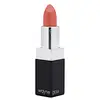What's inside
What's inside
 Key Ingredients
Key Ingredients

 Benefits
Benefits

 Concerns
Concerns

 Ingredients Side-by-side
Ingredients Side-by-side

Ricinus Communis Seed Oil
MaskingSilica
AbrasiveTrioctyldodecyl Citrate
EmollientVegetable Oil
Skin ConditioningTriisostearyl Citrate
EmollientCI 77891
Cosmetic ColorantBeeswax
Emulsion StabilisingButyrospermum Parkii Butter
Skin ConditioningEuphorbia Cerifera Wax
Simmondsia Chinensis Seed Oil
EmollientSynthetic Wax
AbrasiveCalcium Aluminum Borosilicate
CI 77491
Cosmetic ColorantCopernicia Cerifera Wax
Cetyl Ricinoleate
EmollientHydrogenated Vegetable Oil
EmollientTocopherol
AntioxidantPhenoxyethanol
PreservativeCI 77492
Cosmetic ColorantGlycine Soja Oil
EmollientJojoba Esters
EmollientCI 15850
Cosmetic ColorantHelianthus Annuus Seed Wax
Skin ConditioningVanillin
MaskingCI 77499
Cosmetic ColorantAcacia Decurrens Flower Wax
EmollientPolyglycerin-3
HumectantIron Oxides
Ricinus Communis Seed Oil, Silica, Trioctyldodecyl Citrate, Vegetable Oil, Triisostearyl Citrate, CI 77891, Beeswax, Butyrospermum Parkii Butter, Euphorbia Cerifera Wax, Simmondsia Chinensis Seed Oil, Synthetic Wax, Calcium Aluminum Borosilicate, CI 77491, Copernicia Cerifera Wax, Cetyl Ricinoleate, Hydrogenated Vegetable Oil, Tocopherol, Phenoxyethanol, CI 77492, Glycine Soja Oil, Jojoba Esters, CI 15850, Helianthus Annuus Seed Wax, Vanillin, CI 77499, Acacia Decurrens Flower Wax, Polyglycerin-3, Iron Oxides
Caprylic/Capric Triglyceride
MaskingVegetable Oil
Skin ConditioningEuphorbia Cerifera Wax
Beeswax
Emulsion StabilisingButyrospermum Parkii Butter
Skin ConditioningOzokerite
Emulsion StabilisingHydrogenated Vegetable Oil
EmollientMangifera Indica Seed Butter
Skin ConditioningPhenoxyethanol
PreservativeTocopheryl Acetate
AntioxidantLimnanthes Alba Seed Oil
Skin ConditioningHydrogenated Olive Oil
Skin ConditioningHelianthus Annuus Seed Oil
EmollientTetrahexyldecyl Ascorbate
AntioxidantButyrospermum Parkii Butter Extract
Skin ConditioningCI 77891
Cosmetic ColorantCI 19140
Cosmetic ColorantCI 45380
Cosmetic ColorantCaprylic/Capric Triglyceride, Vegetable Oil, Euphorbia Cerifera Wax, Beeswax, Butyrospermum Parkii Butter, Ozokerite, Hydrogenated Vegetable Oil, Mangifera Indica Seed Butter, Phenoxyethanol, Tocopheryl Acetate, Limnanthes Alba Seed Oil, Hydrogenated Olive Oil, Helianthus Annuus Seed Oil, Tetrahexyldecyl Ascorbate, Butyrospermum Parkii Butter Extract, CI 77891, CI 19140, CI 45380
Ingredients Explained
These ingredients are found in both products.
Ingredients higher up in an ingredient list are typically present in a larger amount.
Beeswax is natural wax produced by honey bees and can be synthetically created. It consists mainly of fatty acid esters and long-chain alcohols.
In cosmetics, beeswax is a emollient. Due to its waxy structure, it creates a protective barrier. This barrier prevents water from evaporating off the skin.
This may not be a good ingredient for oily skin. We recommend speaking with a professional if you have concerns.
Beeswax cannot be removed with water, but can be taken off with an oil cleanser.
Beeswax is also antiseptic and contains vitamin A.
Learn more about BeeswaxThis ingredient is also known as shea butter. It is an effective skin hydrator and emollient.
Emollients help soothe and soften your skin. It does this by creating a protective film on your skin. This barrier helps trap moisture and keeps your skin hydrated. Emollients may be effective at treating dry or itchy skin.
Shea butter is rich in antioxidants. Antioxidants help fight free-radicals, or molecules that may harm the body. It is also full of fatty acids including stearic acid and linoleic acid. These acids help replenish the skin and keep skin moisturized.
While Shea Butter has an SPF rating of about 3-4, it is not a sunscreen replacement.
Shea butter may not be fungal acne safe. We recommend speaking with a professional if you have any concerns.
Learn more about Butyrospermum Parkii ButterCi 77891 is a white pigment from Titanium dioxide. It is naturally found in minerals such as rutile and ilmenite.
It's main function is to add a white color to cosmetics. It can also be mixed with other colors to create different shades.
Ci 77891 is commonly found in sunscreens due to its ability to block UV rays.
Learn more about CI 77891Hydrogenated Vegetable Oil is created by adding hydrogen to vegetable oil in order to give it more stability. This process also raises the melting point of vegetable oil. In cosmetics, it is an emollient.
Emollients help soothe and soften the skin. They do this by creating a protective film on your skin. This barrier helps trap moisture and keeps your skin hydrated. Emollients may be effective at treating dry or itchy skin.
The term "Hydrogenated Vegetable Oil" is an umbrella term and can refer to a variety of vegetable oils and blends of: sunflower oil, soybean oil, olive oil, coconut oil, palm oil, and more.
Due to the differences in vegetables, the benefits may vary.
Learn more about Hydrogenated Vegetable OilPhenoxyethanol is a preservative that has germicide, antimicrobial, and aromatic properties. Studies show that phenoxyethanol can prevent microbial growth. By itself, it has a scent that is similar to that of a rose.
It's often used in formulations along with Caprylyl Glycol to preserve the shelf life of products.
Vegetable oil is created from seeds or parts of plants.
The term "vegetable Oil" is an umbrella term. It can refer to a variety of vegetable oils and/or blends of: sunflower oil, soybean oil, olive oil, coconut oil, palm oil, and more.
This ingredient is an emollient. Emollients help soothe and soften the skin. They do this by creating a protective film on your skin. This barrier helps trap moisture and keeps your skin hydrated. Emollients may be effective at treating dry or itchy skin.
Due to the differences in vegetables, the benefits may vary.
Learn more about Vegetable OilEuphorbia Cerifera wax comes from a shrub in Northern Mexico. It is used to stabilize formulations and has emollient properties.
Emollients form a thin layer on top of skin to prevent water from evaporating, keeping skin and lips hydrated.
According to a manufacturer, this wax can range from a yellow/brown color to translucent.
Learn more about Euphorbia Cerifera Wax